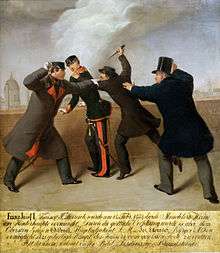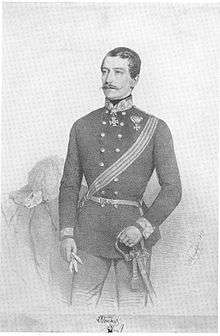Maximilian Karl Lamoral O'Donnell
Maximilian Karl Lamoral Graf O’Donnell von Tyrconnell (October 29, 1812 — July 14, 1895) was an Austrian officer and civil servant who became famous when he helped save the life of Emperor Franz Josef I of Austria. O'Donnell was a descendant of the Irish noble dynasty of O'Donnell of Tyrconnell.[1]
Maximilian Karl Lamoral O'Donnell | |
|---|---|
 Maximilian Karl Lamoral O'Donnell in 1860 | |
| Born | October 29, 1812 Goldegg, Kingdom of Bavaria |
| Died | July 14, 1895 (aged 82) Salzburg, Austria-Hungary |
| Noble family | O'Donnell |
| Spouse(s) | Franziska Wagner |
| Father | Maurice O'Donnell |
| Religion | Roman Catholicism |
Family background
He was born in Goldegg, son of Count Maurice O'Donnell (Moritz Graf O'Donnell) (1780–1843), and Christine (4 January 1788 – 19 May 1867), the legitimate daughter of Charles Joseph, Prince de Ligne. He married Franziska Wagner, who was not of noble birth, and the marriage was frowned upon. He died in his home in Salzburg and is buried in the Salzburg Cemetery.
Military career
He was educated in Dresden, then joined the military and served in several engagements in Europe, including in Italy in 1848, and Hungary in 1849, resulting in many awards and promotion. He became aide-de-camp to the Emperor Franz Josef I of Austria. He later served as Governor of Lombardy briefly from 18–22 March 1848.
Fame as life-saver

On February 18, 1853, Maximilian helped save the life of the young Emperor, foiling an assassination attempt by a tailor and former Hussar, János Libényi, a Hungarian nationalist.[2] The Emperor was taking a stroll with Count Maximilian O’Donnell on a city-bastion, inside Vienna, and at about 1 pm. At the moment he looked over the parapet to review an exercise of troops,[3] Libényi approached and struck the Emperor in the neck from behind with a knife. Even though the Emperor was wounded and bleeding, his collar may have helped save his life. Maximilian Graf O'Donnell struck Libényi down with his sabre.[4] Another witness who happened to be nearby, the butcher Joseph Ettenreich, quickly overwhelmed Libényi. For this deed, he was later elevated to nobility by the Emperor and became Joseph von Ettenreich. Libényi was subsequently put on trial and condemned to death for attempted regicide. He was executed near the Spinnerin am Kreuz in the Favoriten-district.
After the unsuccessful attack the Emperor's brother Ferdinand Maximilian Joseph, the later Emperor of Mexico, called upon the Europe's royal families for donations to construct a new church on the site of the attack. The church was to be a votive offering for the rescue of the Emperor. It is located on Ringstraße in the district of Alsergrund close to the University of Vienna, and is known as the Votivkirche.
Honours and awards

Maximilian O’Donnell already held a German Habsburg title of Count, granted to his great-grandfather.[lower-alpha 1] However, after successfully rescuing the Emperor, he was additionally honoured and made a Count of the Habsburg Austrian Empire (Reichsgraf), but an error occurred in the Letters Patent, omitting one “n” from the family name, and the Austrian O’Donnells have since then usually used “O’Donell” as the standard version.
Maximilian was also honoured with orders of chivalry by several European monarchs, and made a Freeman of the cities of Vienna, Prague, Pest, Laibach (Ljubljana), and others. He was also awarded the Commander's Cross of the Imperial Order of Leopold, and his customary O'Donnell arms were augmented by the initials and shield of the ducal House of Austria, with additionally the double-headed eagle of the Empire. These arms can still be seen emblazoned on the portico of no. 2 Mirabellplatz in Salzburg, where O'Donnell built his residence thereafter in the former gardens of Schloss Mirabell.[1]
Descent from Niall of the Nine Hostages[5]
- Maximilian Karl Lamoral O'Donnell
- Maurice Count O'Donnell
- Joseph Count O'Donnell
- Major-General Henry Count O'Donnell
- Calbhach Dubh O'Donnell, of Oldcastle
- Colonel Calbhach Ruadh O'Donnell
- Colonel Manus O'Donnell
- Conn Oge O'Donnell
- Conn O'Donnell
- Calvagh O'Donnell, King of Tír Chonaill
- Manus O'Donnell, King of Tír Chonaill
- Hugh Dubh O'Donnell, King of Tír Chonaill
- Hugh Ruadh O'Donnell, King of Tír Chonaill
- Niall Garbh O'Donnell, King of Tír Chonaill
- Turlough an Fiona O'Donnell, King of Tír Chonaill
- Niall Garbh O'Donnell, King of Tír Chonaill
- Hugh O'Donnell, King of Tír Chonaill
- Domhnall Óg Ó Domhnaill, King of Tír Chonaill
- Donal Mór O'Donnell, King of Tír Chonaill
- Eignechan O'Donnell, King of Tír Chonaill
- Donnchadh O'Donnell
- Donal O'Donnell
- Hugh O'Donnell
- Tadg O'Donnell
- Conn O'Donnell
- Cathbharr O'Donnell
- Giollachriosd O'Donnell
- Cathbharr
- Domhnaill
- Eignechan
- Dálach
- Muirchertach
- Ceannfola
- Arnall
- Maolduin
- Ceannfola
- Garbh
- Ronan
- Lughach
- Fergus
- Seadnach
- Fergus Ceanfada
- Conall Gulban
- Niall of the Nine Hostages, High King of Ireland
Notes
- Maximilian’s great-grandfather was Major General Count Henry O’Donnell (1726-1789), Commander of the O’Donnell No.5 Cuirassier Regiment who married Princess Leopoldine Cantacuzino, a descendant of the Byzantine Emperors through the Russian branch of the Moldavian Cantacuzinos, in Pressburg (Bratislava)
References
- O'Domhnaill Abu (Spring 1987) O'Donnell Clan Newsletter no.7, (ISSN 0790-7389)
- The Wild Geese in Austria - Irish Soldiers and Civilians in the Habsburg Service (1618-1918), published by the National Museum of Ireland, with foreword by H.E. Dr. Paul Leifer, Ambassador of Austria to Ireland
- Extract from the Prussian Gazette of 18 February 1853, Periodical in Bibliotheque Nationale de Luxembourg
- "Attentat auf Kaiser Franz Joseph I". Wo in Wein (in German). Archived from the original on 2013-02-05. Retrieved 2013-02-05.
- John O'Hart,"Irish Pedigrees or the Origin and Stem of the Irish Nation", Volume 1, 1892, p.649, https://archive.org/details/irishpedigreesor_01ohar/page/648
External links
- Vienna City Website with portraits of Emperor's Rescue ("Attentat auf Kaiser Franz Joseph I". Wo in Wein (in German). Archived from the original on 2013-02-05. Retrieved 2013-02-05.)